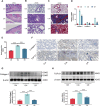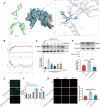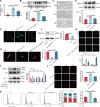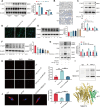Resveratrol attenuates inflammation and fibrosis in rheumatoid arthritis-associated interstitial lung disease via the AKT/TMEM175 pathway
- PMID: 38745204
- PMCID: PMC11095009
- DOI: 10.1186/s12967-024-05228-1
Resveratrol attenuates inflammation and fibrosis in rheumatoid arthritis-associated interstitial lung disease via the AKT/TMEM175 pathway
Abstract
Background and purpose: Interstitial lung disease (ILD) represents a significant complication of rheumatoid arthritis (RA) that lacks effective treatment options. This study aimed to investigate the intrinsic mechanism by which resveratrol attenuates rheumatoid arthritis complicated with interstitial lung disease through the AKT/TMEM175 pathway.
Methods: We established an arthritis model by combining chicken type II collagen and complete Freund's adjuvant. Resveratrol treatment was administered via tube feeding for 10 days. Pathological changes in both the joints and lungs were evaluated using HE and Masson staining techniques. Protein expression of TGF-β1, AKT, and TMEM175 was examined in lung tissue. MRC-5 cells were stimulated using IL-1β in combination with TGF-β1 as an in vitro model of RA-ILD, and agonists of AKT, metabolic inhibitors, and SiRNA of TMEM175 were used to explore the regulation and mechanism of action of resveratrol RA-ILD.
Results: Resveratrol mitigates fibrosis in rheumatoid arthritis-associated interstitial lung disease and reduces oxidative stress and inflammation in RA-ILD. Furthermore, resveratrol restored cellular autophagy. When combined with the in vitro model, it was further demonstrated that resveratrol could suppress TGF-β1 expression, and reduce AKT metamorphic activation, consequently inhibiting the opening of AKT/MEM175 ion channels. This, in turn, lowers lysosomal pH and enhances the fusion of autophagosomes with lysosomes, ultimately ameliorating the progression of RA-ILD.
Conclusion: In this study, we demonstrated that resveratrol restores autophagic flux through the AKT/MEM175 pathway to attenuate inflammation as well as fibrosis in RA-ILD by combining in vivo and in vitro experiments. It further provides a theoretical basis for the selection of therapeutic targets for RA-ILD.
Keywords: Autophagy; RA-ILD; Resveratrol; TMEM175.
© 2024. The Author(s).
Conflict of interest statement
The authors declare that they have no known competing financial interests or personal relationships that could have appeared to influence the work reported in this paper.
Figures







References
Publication types
MeSH terms
Substances
Grants and funding
- 2018085MH264/the Natural Science Foundation of Anhui Province
- 2022sfy010/the Basic and Clinical Cooperative Research Program of Anhui Medical University-Incubation Project for The Third Affiliated Hospital
- 2023AH050607/the Scientific research projects of universities in Anhui Province
- 2021xkj004/the Youth Science Foundation of Anhui Medical University
LinkOut - more resources
Full Text Sources
Medical

